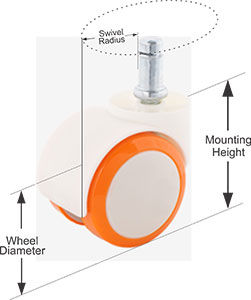The nominal diameter of the outside of the wheel, this typically describes the basic size of the Castor (i.e. a 2” wheel diameter caster is typically referred to as a 2” Castor).
The distance from the center of the fastening to the outer most point of the Castor. This specifies the minimum clearance required for a mounted Castor to swivel a full 360 degrees.

The vertical distance between the bottom of the wheel and the mounting point of the unit.
The load on a Castor is designed to carry on a continuous basis. Load is assigned on a per Castor basis. To determine the load based on the number of Castors on a unit, divide the total weight by the number of castors. For Example: A Chair needs to support up to 250kgs and will use 5 casters. Castors, 250kg / 5
castors = 50kg load rating required per castor
Divide the load capacity needed by the number of Castors your product will be using. For example, your drawer unit will need to carry 100 kgs and will use 4 casters: 100kgs / 4 casters = 25kg load per caster would be sufficient for your unit.

The best and easiest way to improve movement is to choose the largest diameter wheel practical for your application. Wheel width must all be taken into consideration- are you going to move your product over large grating or large thresholds? Selecting a tread material should be based upon the environment your Castors will spend majority of their time on. Typically the harder the surface (tile, etc.), the softer the wheel you would want to use for protection. The softer the surface (thick carpet, etc), the harder the wheel you want to use for easy movements. To the right is a chart detailing which materials are recommended on particular flooring materials.
Call now: +91 22 2679 0437
Write us at: [email protected]
Copyright © Regal Castors. All Rights Reserved.